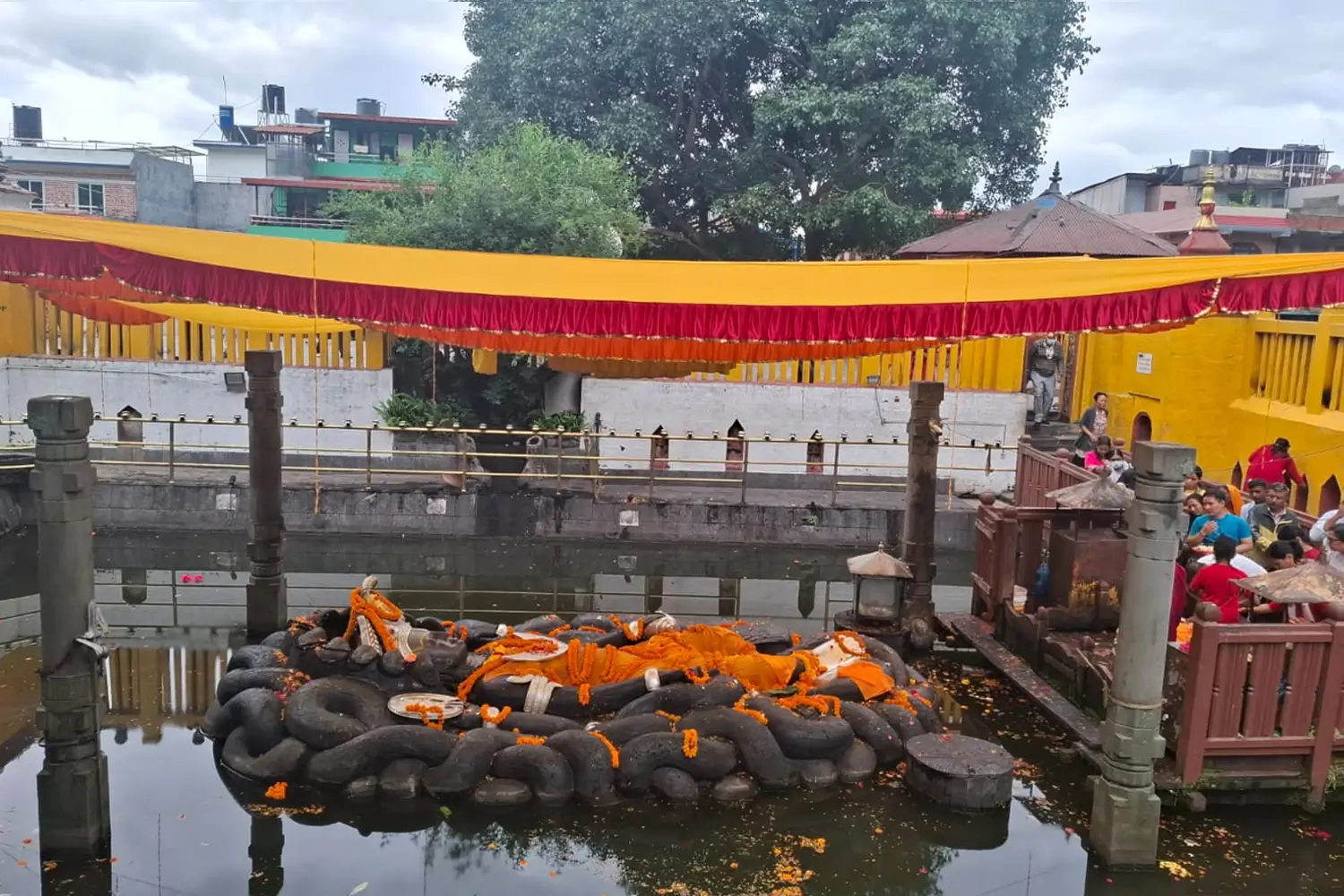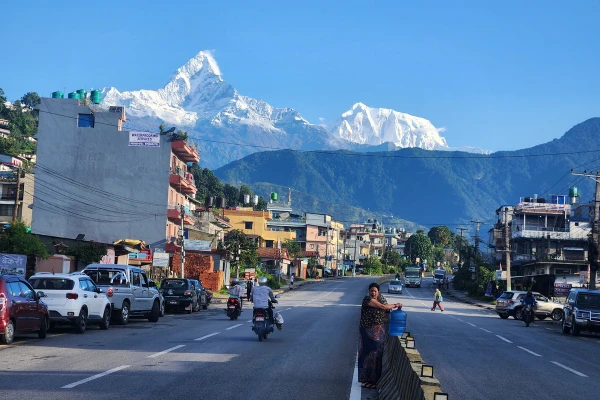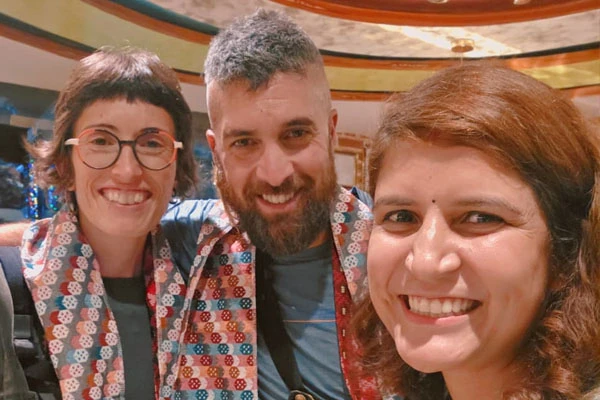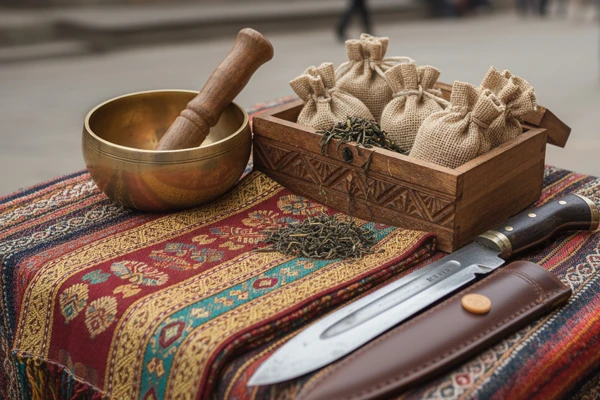Budhanilkantha Temple – Complete Guide to Nepal’s Iconic Lord Vishnu Shrine
📍 Location: 8 km north of Kathmandu, at the base of Shivapuri Hills
🕉️ Deity: Lord Vishnu (Reclining – Ananta Shayana)
⏰ Visiting Hours: Early morning to late evening

Nestled at the foot of the Shivapuri Hills, Budhanilkantha Temple is one of Nepal’s most revered Hindu pilgrimage sites, famed for its enormous black basalt statue of Lord Vishnu reclining on the cosmic serpent Ananta Shesha. The temple combines spiritual devotion, cultural heritage, and natural beauty, making it a must-visit destination for pilgrims, tourists, historians, and photographers alike.
🏛️ Introduction to Budhanilkantha Temple
Budhanilkantha is renowned not only for its religious significance but also for its stunning architectural and natural setting. Surrounded by verdant forests, serene ponds, and the majestic backdrop of Shivapuri National Park, the temple exudes a sense of calm and spiritual energy that attracts thousands of devotees and travelers every year.
This sacred site is a prominent example of Vaishnav worship in Nepal, showcasing the country’s deep-rooted traditions and vibrant religious practices. From ancient legends to daily rituals, Budhanilkantha represents a living, breathing heritage site that continues to influence Nepalese culture, spirituality, and tourism.
📜 Historical and Religious Background
Mythological Origins of the Reclining Vishnu
The Ananta Shayana Vishnu statue symbolizes Lord Vishnu resting in the cosmic ocean during the interval between the destruction and creation of the universe. This posture, known as Ananta Shayana, reflects eternal rest, preservation of cosmic balance, and divine meditation.
Length of Statue: ~5 meters (16.4 feet)
Material: Single block of black basalt
Period: Believed to date back to the Licchavi period (7th–8th century)
💡 Legend: Local farmer Nilkantha discovered the statue while plowing a field. Striking the buried stone revealed its divine presence, giving the temple its name “Budhanilkantha,” which literally means “Old Blue-Throated”, a reference to Lord Vishnu’s divine form.
Religious Practices at Budhanilkantha
Worship at Budhanilkantha is performed according to traditional Vaishnav rituals, reflecting centuries of spiritual devotion:
Daily Abhishekam: Ceremonial bathing of the deity using milk, water, ghee, and honey
Offerings: Flowers, incense, and Vedic chanting
Temple Access: Open from early morning to late evening
Major Festivals
🌕 Haribodhini Ekadashi (October–November): Marks Lord Vishnu’s awakening from cosmic sleep
🎉 Vishnu Jayanti (April): Celebrates the birth of Lord Vishnu
🗓️ Monthly Ekadashi: Devotees fast and perform special prayers
🕉️ Buddha Purnima: Hindu-Buddhist procession linking the temple with nearby monasteries
These festivals not only highlight Hindu devotional practices but also attract cultural tourism, strengthening Nepal’s spiritual tourism sector.
Royal Legends and Prophecies
One of the most fascinating stories linked to Budhanilkantha involves King Pratap Malla (1641–1674), a notable ruler of Kathmandu during the Malla period. The king attempted to replicate the spiritual power of Budhanilkantha by consecrating a new Vishnu statue near Hanuman Dhoka Durbar Square.
He collected sacred water from all known religious sources except Budhanilkantha
The deity appeared in a dream, warning the king never to visit Budhanilkantha
Result: A royal tradition emerged; no reigning monarchs of Nepal would ever enter the temple, a practice respected for centuries
This legend adds a layer of mystique and reverence, reinforcing Budhanilkantha’s unique status as a spiritual and historical landmark.
Buddhist Connections and Local Beliefs
Although primarily a Hindu temple, Budhanilkantha holds spiritual significance for Buddhists:
Bishnumati River (formerly Keshawati): Lord Krakur Chand Buddha is said to have performed sacred rites along its banks
Buddha Purnima Jatra: Pilgrims follow a procession from Yeja through Bagdwar to Chandeshwori Temple in Tokha, reflecting religious confluence
Nearby Ved Ashram welcomes Buddhist devotees, highlighting the temple’s interfaith harmony
These connections underscore Budhanilkantha’s role as a cultural and religious hub in the Kathmandu Valley.
🗿 Temple Structure and Iconography
Open-Air Sanctuary
Budhanilkantha Temple is a rare open-air Vaishnav sanctuary. The central feature is the magnificent black basalt statue of Lord Vishnu, reclining gracefully on the multi-headed Ananta Shesha.
Symbolizes cosmic rest and eternal protection
Represents Yoga Nidra, a meditative state where the deity remains aware of cosmic events
Symbolic Items of Lord Vishnu
🐚 Shankha (Conch): Purity, divine vibration, auspiciousness
🔄 Sudarshan Chakra (Disc): Protection of dharma, destruction of evil
💪 Gada (Mace – Kaumodaki): Strength, discipline, authority
💎 Jewel or Lotus: Spiritual wisdom, enlightenment, purity
The deity lies serenely on the coils of Ananta Shesha, the many-hooded cosmic serpent, whose presence signifies the Lord’s eternal existence and unending protection. The divine serpent gently supports Lord Vishnu as He floats in a posture of Ananta Shayana, a symbolic state of Yoga Nidra—cosmic sleep.
This celestial imagery reflects the depiction of Vaikuntha, the eternal abode of Lord Vishnu, where He rests on the cosmic ocean (Kshira Sagar). According to Hindu tradition, during the four holy months of Chaturmasya (July to November), Lord Vishnu enters a state of meditative rest. This period is spiritually significant for Vaishnavas, who intensify their devotional practices, fast from certain foods, and engage in acts of penance to seek the Lord’s blessings.
However, Lord Vishnu’s Yoga Nidra is not like the unconscious sleep of ordinary beings. While appearing to rest, the Lord remains fully aware of all cosmic happenings—both in the material and spiritual worlds. His divine rest is a powerful form of meditation and cosmic regulation, during which He lovingly observes His devotees performing their rituals, austerities, and prayers.
This sacred layout, with the deity resting in divine stillness amidst the peaceful surroundings of the Shivapuri Hills, creates a deeply spiritual atmosphere that continues to draw pilgrims, art enthusiasts, historians, and spiritual seekers from all over the world.
Iconic Craftsmanship and Inscriptive Evidence
Historical narratives suggest that King Bhimarjun Dev, a ruler of the Licchavi period, desired to create a grand statue of Lord Vishnu. For this, he ordered a large stone to be fetched from the southern region of Kathmandu, specifically from a place called Kothakha in Godawari. The task of transporting the stone was initially undertaken by the people of Sunakothi near the Bhringareshwor Temple. Once the stone reached Sunakothi, the king, pleased with their service, asked what they desired in return. The locals requested exemption from the prevailing system of collective punishment—where entire families could be penalized for an individual’s crime under the rule of pancha dosh (five offenses). The king granted this request, marking a rare early example of social reform.
Subsequently, the stone was transported further by the people of Lagantole, a part of Dakshin Koliya Gram. When asked what they wanted in return, they sought royal permission to wear jewelry, a privilege previously reserved for royalty or select classes. The king granted their wish as well.
Interestingly, two separate stone inscriptions—one in Sunakothi and another in Yangal Hiti (Lagantole)—support this historical narrative and attest to the administrative decisions made by the king. However, despite the importance of the statue itself, there is no inscription found directly on the Budhanilkantha idol. This absence is notable, as most sacred murtis of the era contain a pada pitha or dedicatory inscription.
During the reign of King Bhimarjun Dev in the Licchavi period, Vishnu Gupta held significant administrative power and influence. His contributions and authority were so prominent that his name appears in the stone inscriptions associated with the transportation and establishment of the Budhanilkantha statue.
The statue is popularly known today as Budhanilkantha, but its original name is believed to be Shesh Shayi Vishnu—Vishnu resting upon the cosmic serpent Shesh Naag. This representation reflects deep Vaishnav symbolism, with Lord Vishnu depicted in a reclining position, embodying peace, preservation, and cosmic balance.
This rich historical context makes Budhanilkantha both a religious and cultural treasure.
🌳 Local Attractions & Activities
1. Radha Krishna Temple (ISKCON) – 1 km away
Daily aarti and kirtans
Complimentary vegetarian prasadam
Ideal for meditation and spiritual learning
2. Jamchen Ghompa Monastery
Tibetan-style monastery with panoramic views
Prayer flags, murals, and Buddha statues
Functions as a center for study, meditation, and devotion
3. One-Day Hike to Bagdwar
Source of holy Bagmati River
Trail through Shivapuri Nagarjun National Park
Entry Fee: NPR 100 (Nepalis), NPR 1000 (foreigners)
4. Tarebhir Hiking Trail
Panoramic views of Kathmandu Valley
Family-friendly, ideal for photography and birdwatching
5. Traditional Villages
Experience Newar and Tamang culture
Observe traditional crafts, home-cooked meals, and lifestyles
6. Tokha Village
Historic Newari settlement
Famous for Chaku (molasses toffee) and Lakhamari
Festivals showcase Newari rituals, dances, and music
7. Local Markets & Souvenirs
Handicrafts: wood carvings, silver jewelry, woolen shawls
Supports local artisans and promotes sustainable tourism
8. Vipassana Meditation Centre (Dhamma Shringa)
- Residential 10-day meditation courses
- Peaceful environment in Shivapuri National Park
- Focus on self-discovery and mental purification
🧳 Travel Tips
Wear comfortable shoes and modest attire
Respect rituals and photography restrictions
Carry water, snacks, and sun protection
Combine your visit with Shivapuri National Park or ISKCON Temple
✨ Conclusion
Budhanilkantha Temple is more than a sacred shrine; it is a living testament to Nepal’s spirituality, history, and culture. From the majestic reclining Vishnu statue to scenic hikes, monasteries, and traditional villages, it offers a transformative experience for pilgrims, tourists, and spiritual seekers.
Practicing responsible tourism ensures the preservation of the temple’s natural surroundings, cultural heritage, and community livelihood. Budhanilkantha is not just a destination—it is Nepal’s spiritual heart, inviting you to explore its history, rituals, and serene landscapes.
Contact usif you wish us to organize your day trip to Budhanilkanthe Temple.
Whatsapp Message: Sajana Tripathi
FAQs
1. What is the speciality of Budhanilkantha Temple?
The speciality of Budhanilkantha Temple lies in its massive reclining statue of Lord Vishnu, carved from a single black basalt stone, resting on the coils of the cosmic serpent Ananta. It represents Ananta Shayana (Lord Vishnu in cosmic sleep) and is one of the largest and most visually striking stone statues in Nepal. Its open-air setting at the base of the Shivapuri Hills adds to the spiritual and scenic uniqueness of the site.
2. What is the mystery of Budhanilkantha Temple?
The temple holds several mysteries and legends:
The statue is carved from a single block of basalt and has survived centuries without any cracks, despite being exposed to the open air.
According to legend, the local farmer Nilkantha discovered the statue while plowing his field, highlighting its divine origin.
A famous royal prophecy says that Nepalese kings must never enter the temple, or they would face untimely death—a tradition respected for centuries.
3. Who made Budhanilkantha?
Budhanilkantha’s statue is believed to have been created during the Licchavi period (7th–8th century) under the reign of King Bhimarjun Dev. While the statue itself does not bear an inscription, historical records mention Vishnu Gupta, who held significant administrative power during King Bhimarjun Dev’s reign, as being instrumental in the temple’s establishment.
4. What are the 4 Narayan temples in Kathmandu?
The Four Narayan Temples in the Kathmandu Valley, which are important for Vaishnav devotees, include:
Bisankhu Narayan - Found in the south of the valley, near Godawari.
Ichangu Narayan – West of Kathmandu, in the Lalitpur district
Changu Narayan – East of Bhaktapur, UNESCO World Heritage Site
Shesh Narayan – South of Kathmandu, near Pharping
These four temples collectively represent the protective presence of Lord Vishnu across the Kathmandu Valley.






